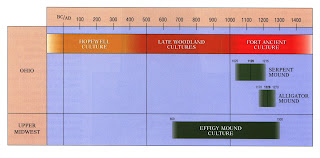 Recently, I had another opportunity to talk to the folks at Ohio’s Wilderness Center. On this occasion, science educator Joann Ballbach, general naturalist Gordon T. Maupin, and conservation biologist Gary Popotnik and I chatted about Serpent Mound as well as Ohio’s other, less renowned, effigy mound, the so-called “Alligator.” Our conversation was recorded and has been posted as part of the January 19th “Wild Ideas” podcast.
Recently, I had another opportunity to talk to the folks at Ohio’s Wilderness Center. On this occasion, science educator Joann Ballbach, general naturalist Gordon T. Maupin, and conservation biologist Gary Popotnik and I chatted about Serpent Mound as well as Ohio’s other, less renowned, effigy mound, the so-called “Alligator.” Our conversation was recorded and has been posted as part of the January 19th “Wild Ideas” podcast.

Serpent Mound, at more than 1400 feet long, is the largest effigy mound in the world whereas “Alligator” Mound is a much smaller 200 feet long. Radiocarbon dating and other evidence situate both of these effigies in the Late Prehistoric era (circa AD 1000-1650), which not coincidentally overlaps the time period when all of the hundreds (or even thousands) of effigy mounds were being built in the Upper Midwest.

My sense is that the Serpent and the “Alligator” mounds represent the Great Serpent and Underwater Panther, masters of the Beneath World in the traditions of many Native American cultures. The folklorist George Lankford, in his book Reachable Stars, argues that the Serpent and Underwater Panther actually are manifestations of one supernatural being: “the Native view, rooted in shape-shifting and symbolic imagery, seems to find much less distinction between the two.” These mounds, then, may have been monumental shrines dedicated to this potent spirit.

My interview is on Podcast #145 and starts at about the 20 minute mark, but you also may enjoy the wide-ranging discussions of various aspects Ohio’s natural environment that precede the conversation about Ohio’s effigy mounds.